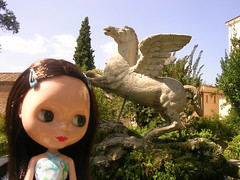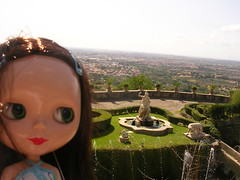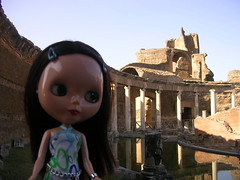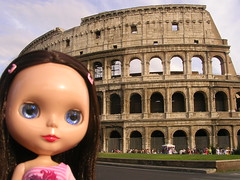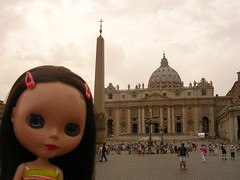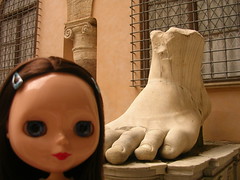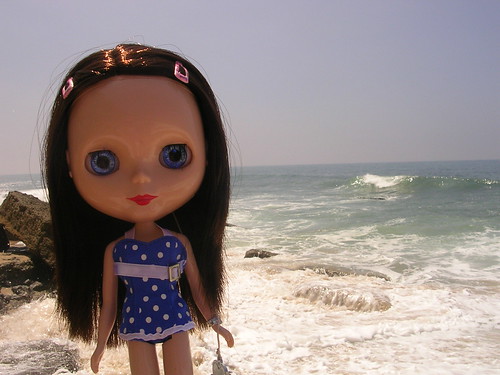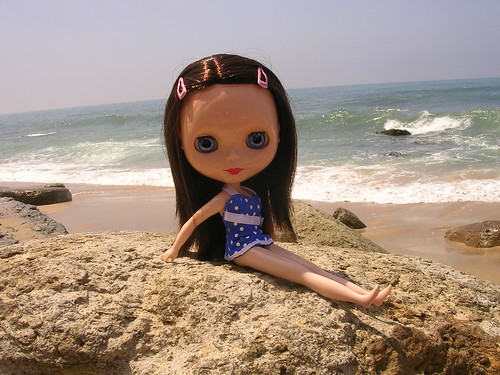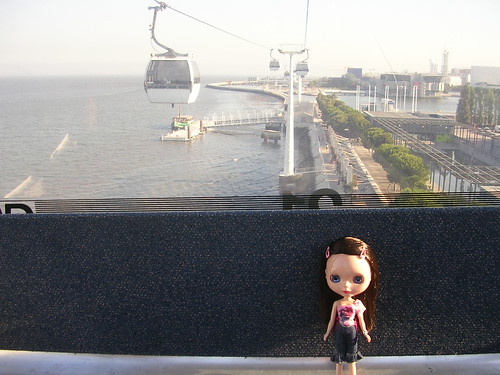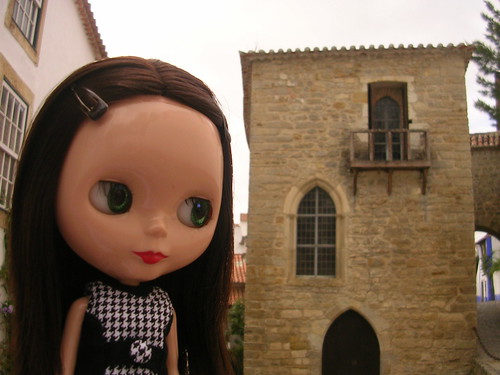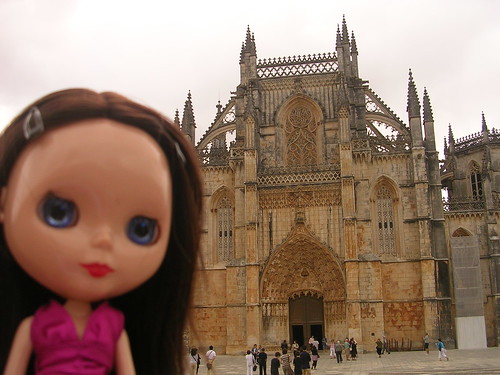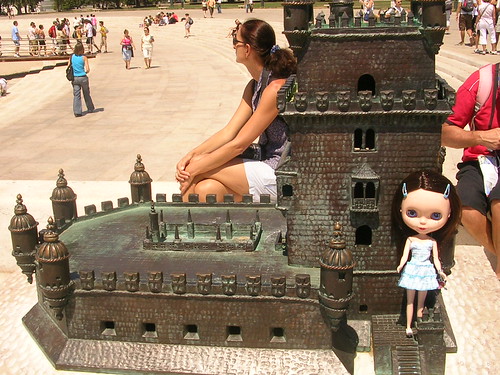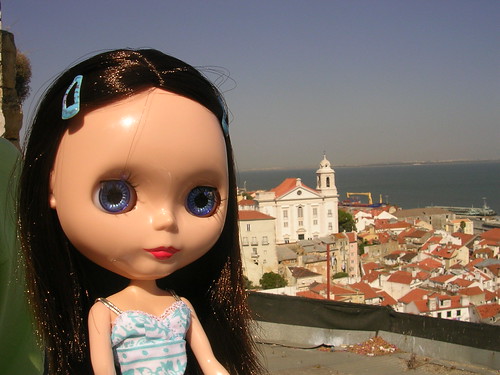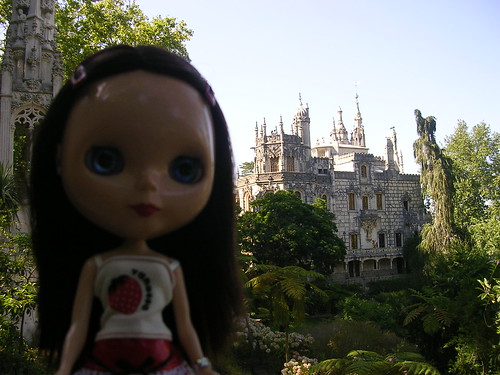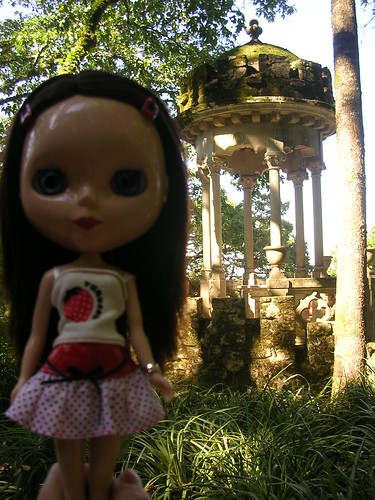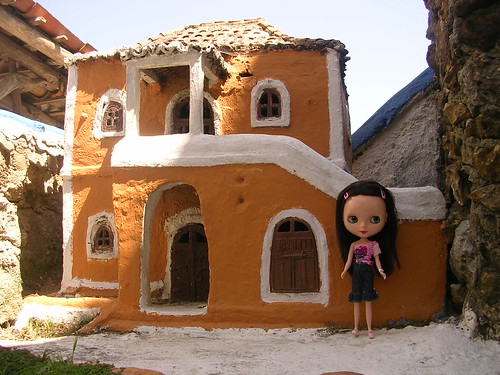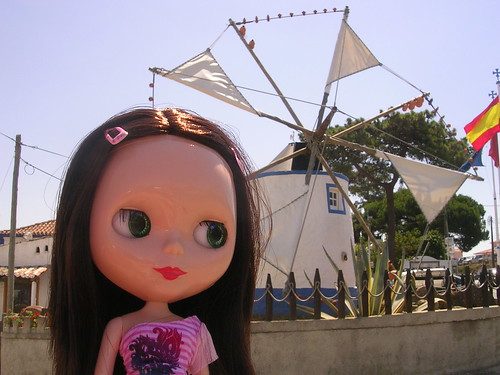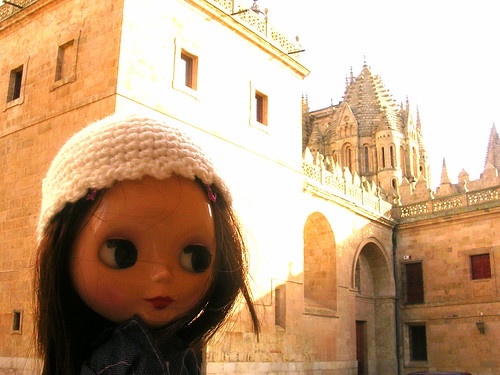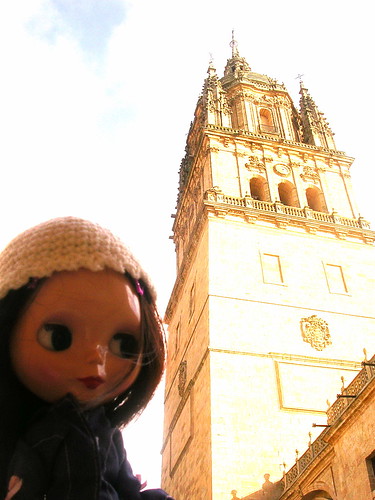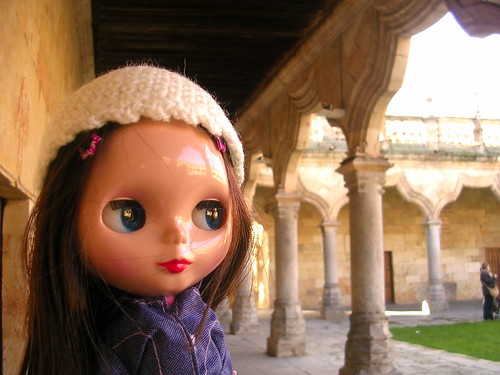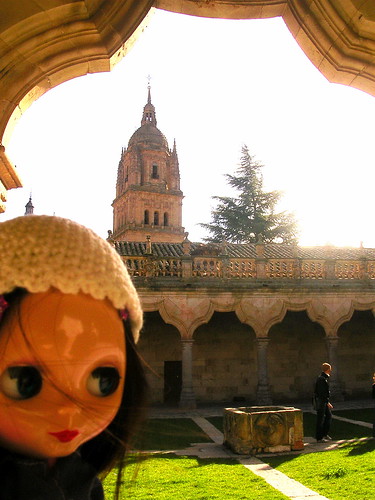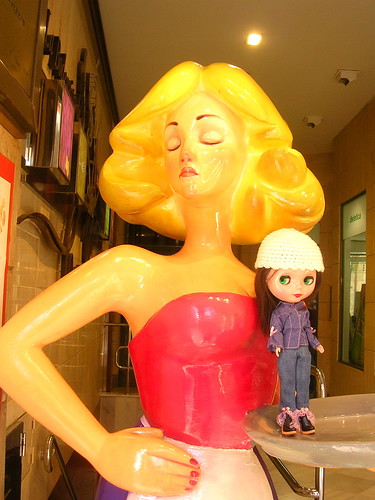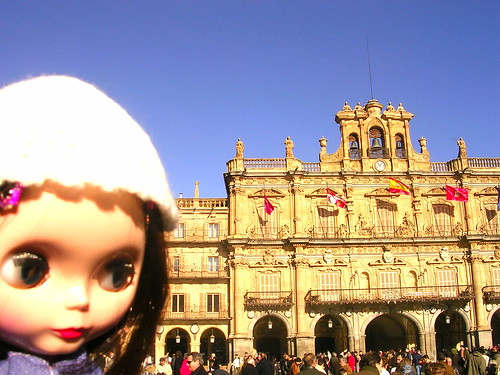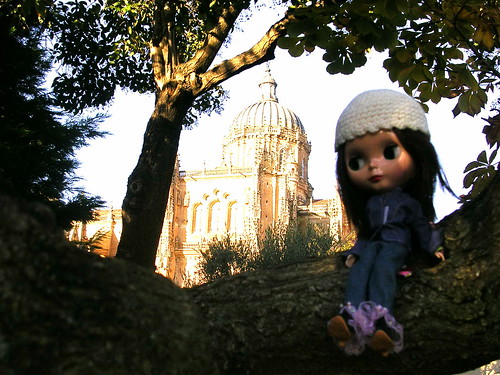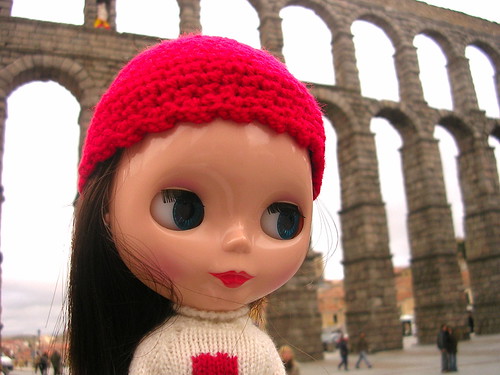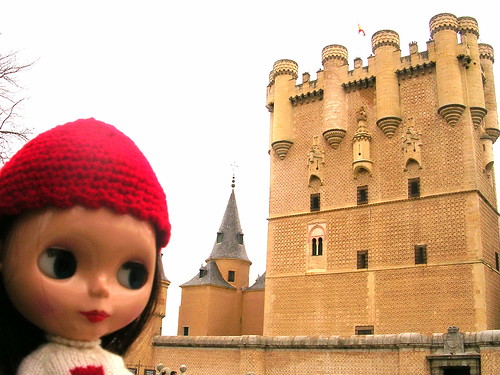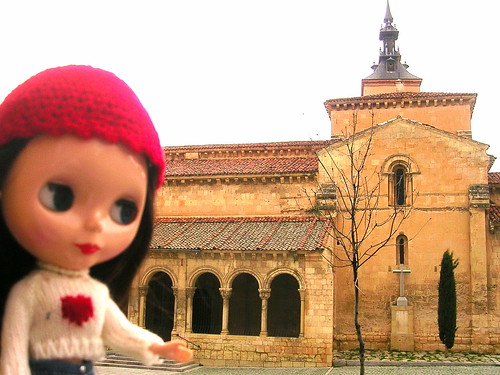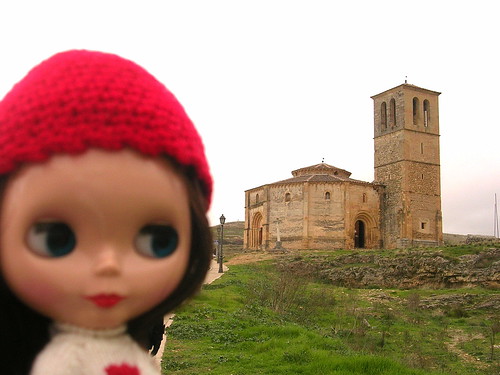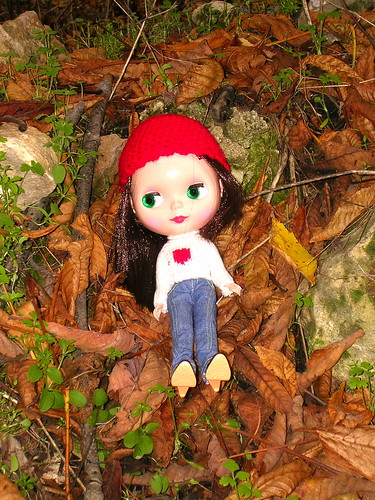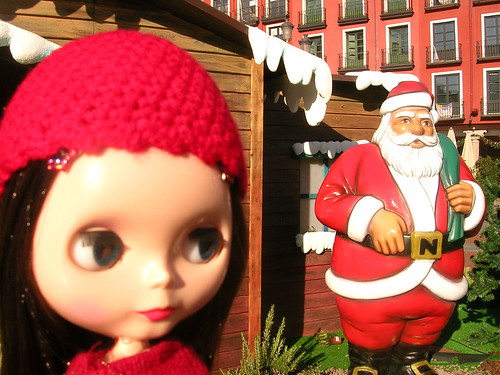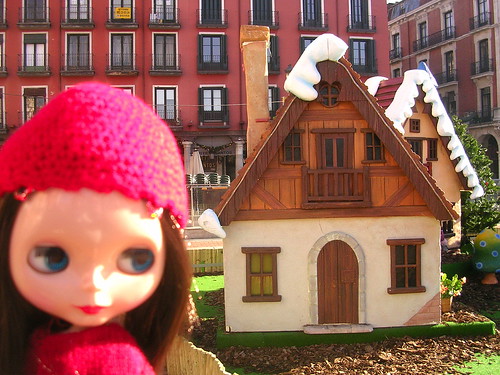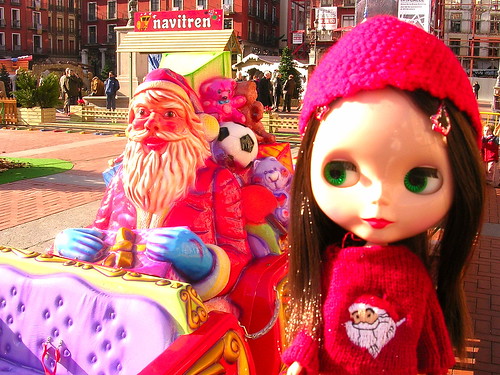Otro día fuimos a visitar otro museo con estatuas romanas antiguas: el Museo Nazionale Romano. En el claustro del edificio, proyectado por Miguel Angel, había unas cuantas estatuas, así que me pude hacer una foto delante de esta Venus. ¿quién es más guapa, ella o yo?
Another day we went to visit another museum with lots of ancient Roman statues: the Museo Nazionale Romano. In the cloister, projected by Michelangelo, there were some statues, so I could have a picture taken in front of that Venus. Who is prettier, she or me?
En el claustro de la iglesia de San Pietro in Montorio, el arquitecto Bramante construyó este pequeño templo o "Tempietto" en el Renacimiento. Dicen que dentro hay un agujero donde estuvo clavada la cruz de San Pedro. Nosotras no lo vimos porque estaba cerrado, sólo pudimos hacer la foto a través de la verja.
In the cloister of San Pietro in Montorio church, the architect Bramante built that little temple or "Tempietto" during the Renaissance. They say that there is a hole inside where once stood the cross where Saint Peter was crucified. We didn't see it because it was closed, so we only could take the picture through the iron gate.
Esta es una de las preciosas vistas de Roma que se pueden disfrutar desde la colina del Gianicolo.
This is one of the beautiful views of Rome you can see from the Gianicolo hill.
Otro día dimos un paseo por el parque de Villa Borghese, porque mami quería visitar el museo Galleria Borghese, con unas preciosas estatuas de Bernini. Lástima que en el museo no se podían hacer fotos, porque son de verdad espectaculares. Después del museo paseamos por el gran parque. Esto es el Tempietto di Diana, imitando un templo romano antiguo.
Another day we took a walk at the Villa Borghese park, because mum wanted to visit the museum Galleria Borghese, where there are several beautiful statues of Bernini. It's a pity that they don't allow to take pictures at the museum, because the statues are really wonderful. After the museum, we took a walk through the big park. This is the Little Temple ("Tempietto") of Diana, an imitation of an ancient Roman temple.
No, no nos hemos ido a Egipto. Esta pirámide la construyeron para un romano llamado Caio Cestio, un magistrado con dinero que quiso que le construyeran este monumento funerario.
No, we haven't gone to Egypt. That pyramid was built for a Roman called Caio Cestio, a rich magistrate who wanted to have such a burial memorial.
Ya que la iglesia del Vaticano está dedicada a San Pedro, San Paolo fuori le Mura está dedicada a San Pablo, y en ella se encuentra su tumba. El claustro tiene estas columnas tan bonitas llenas de mosaicos.
Vatican's church is dedicated to Saint Peter, and that church (San Paolo fuori le Mura) is dedicated to Saint Paul, and inside the church there is Saint Paul's grave. The cloister has got these beautiful columns full of mosaics.
Santa Maria Maggiore es otra de las iglesias importantes de Roma. En el siglo XIV su campanario era el más alto de Roma. Roma está llena de iglesias, hay por todas partes, y no son ermititas, no, cualquier fachada que parece de poca importancia tiene en su interior una iglesia que aquí sería considerada grande. Así que imagináos el tamaño de las grandes basílicas como esta...
Santa Maria Maggiore is another of the important churchs of Rome. In the 14th century his bell tower was the highest of Rome. Rome is full of churches, there are churches everywhere! And they are not little chapels: any normal looking façade hides a church that would be considered big here. So imagine the size of the real "big" basilicas as that one...
Aquí estoy en la famosa Piazza di Spagna, delante de las escaleras de la Trinità dei Monti (que es la iglesia que hay detrás). Como veis, aquí hay otro obelisco, pero este lo están restaurando (llevan así desde el año pasado, dice mami, son unos lentorros). Aquí siempre hay gente, de todos los países, incluído romanos autóctonos. Es un poco como las escaleras de Montmartre en París.
Here I am in the famous Piazza di Spagna (Spain Square), in front of the stairs of Trinità dei Monti (the church on the back). As you can see, there is another obelisk here, but they are restauring it (mum came to Rome last year too, and they were already restauring it, they are sooo slow!). There are always lots of people here. People from all countries, and also real Romans. It's a bit like Montmartre stairs in Paris.
Por fin una amiguita con quien compartir visitas turísticas!
Mami quedó con su amiguita de Madrid, So-Called Anna, que vino con un amigo suyo y también con una amiguita de mi tamaño, Blue Velvet. Muy majos todos, de verdad. Lo pasamos genial.
Mami quedó con su amiguita de Madrid, So-Called Anna, que vino con un amigo suyo y también con una amiguita de mi tamaño, Blue Velvet. Muy majos todos, de verdad. Lo pasamos genial.
Aquí con mi amiguita Blue Velvet posando como turistas que éramos en la Piazza de Spagna. Como se dice habitualmente "En Roma haz como los romanos", y no podía faltar una foto en la Piazza di Spagna, por supuesto.
At least a little friend to share sightseeing visits with!
Mum met in Rome her friend from Madrid So-Called Anna, who came with a friend and also with a little friend of my size called Blue Velvet. All of them are really lovely! We had a very good time.
Here I am with Blue Velvet in Piazza di Spagna, doing as the other tourist do normally: posing for a typical picture! As they say: "In Rome do as Romans do", and we wanted our picture taken in Piazza di Spagna, of course!
Aquí estamos las 2 delante de la famosísima Fontana di Trevi. Como nos encantó Roma, echamos una moneda en la fuente. La tradición dice que si te pones de espaldas a la fuente y echas una moneda, volverás a Roma. A mami siempre le ha funcionado. ¡Y yo quiero volver pronto!
Here we are both in front of the very famous Fontana di Trevi. As we loved Rome very much, we throw a coin in the fountain. Legend has it that if you stand with your back to the fountain and throw a coin, you will return to Rome. It has always worked with mum. And I want to come back soon!
Aquí estamos las 2 delante de la famosísima Fontana di Trevi. Como nos encantó Roma, echamos una moneda en la fuente. La tradición dice que si te pones de espaldas a la fuente y echas una moneda, volverás a Roma. A mami siempre le ha funcionado. ¡Y yo quiero volver pronto!
Here we are both in front of the very famous Fontana di Trevi. As we loved Rome very much, we throw a coin in the fountain. Legend has it that if you stand with your back to the fountain and throw a coin, you will return to Rome. It has always worked with mum. And I want to come back soon!
